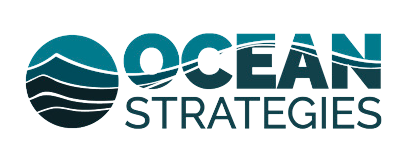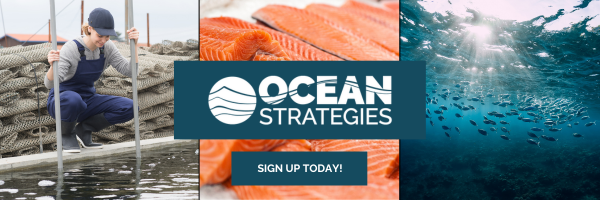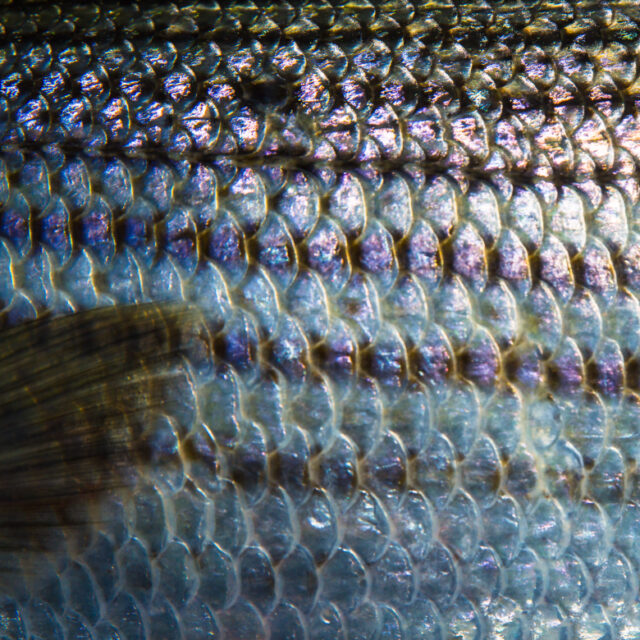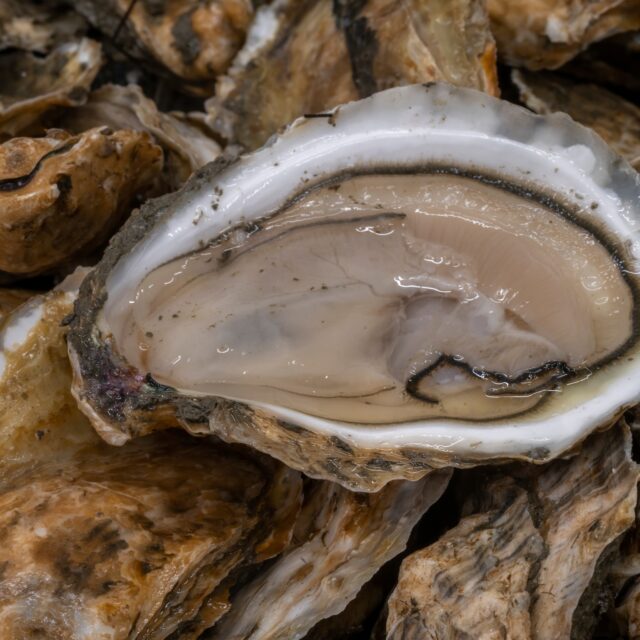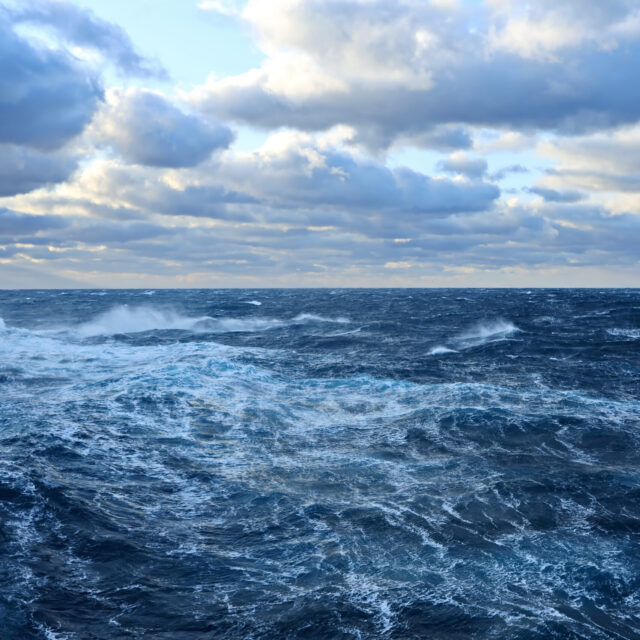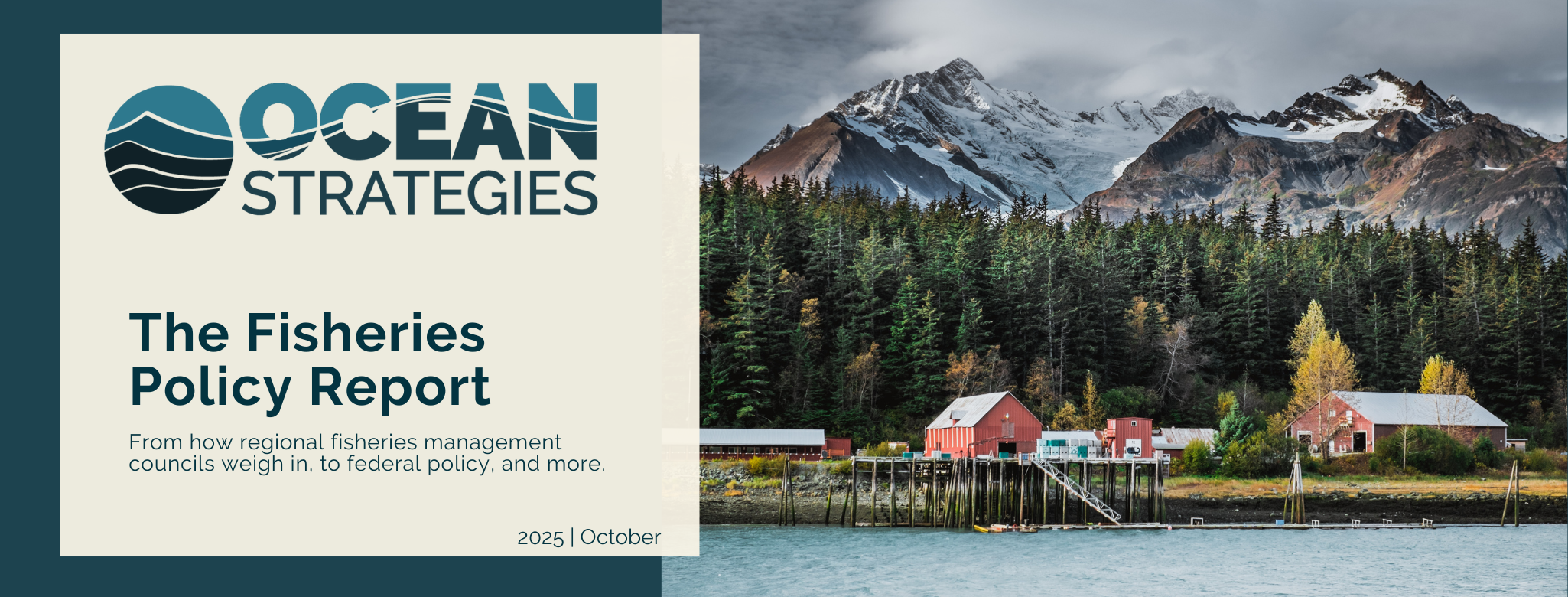
Ocean Strategies is a public affairs firm specializing in seafood, fisheries and marine resources.
This report provides policy and industry updates for those who rely on access to U.S. seafood. Sign up here.
💗 To our Western Alaska community, we send our love. If you are able, here is a place to donate to those impacted by the remnants of Typhoon Halong. 💗
Included In The Report
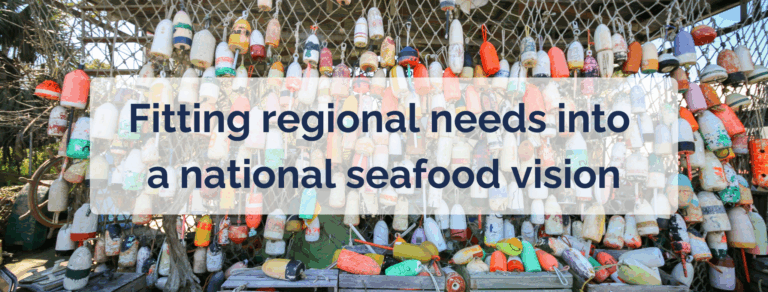
Fisheries Management Councils Are Weighing In on NOAA’s “Seafood Competitiveness” Order
In a later issue we’ll offer analysis of the full public comments, pending the reopening of the federal government and comment publication.
NOAA opened public comment this fall on implementing the Executive Order on U.S. Seafood Competitiveness, inviting ideas on how to “reduce regulatory burdens, improve access, and enhance profitability” across U.S. fisheries. All of the nation’s eight regional fishery management councils responded — offering a rare comparative glimpse at how regional regulators interpret the idea of competitiveness in U.S. seafood, and its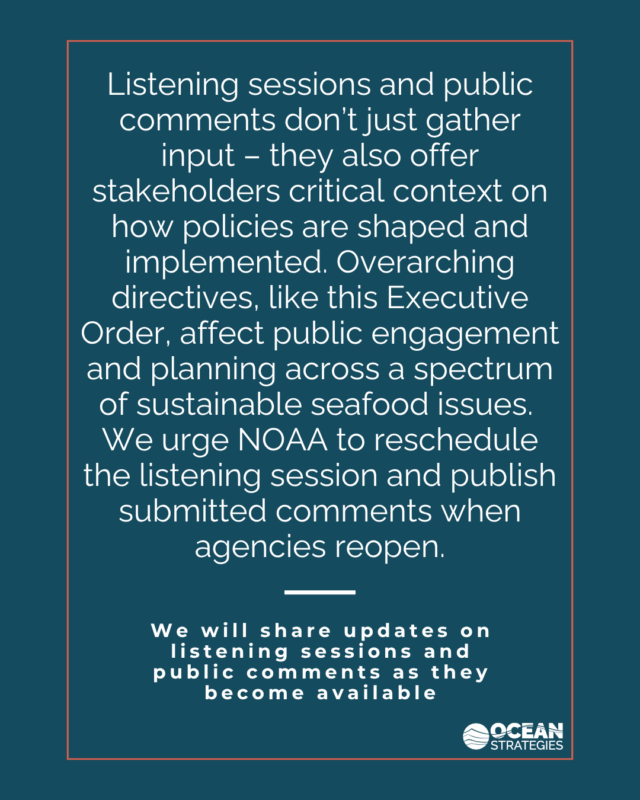 intersection with management.
intersection with management.
Seven council letters were publicly available before the federal shutdown halted the release of the full comment docket: The North Pacific, New England, Gulf, Mid-Atlantic, South Atlantic, Pacific, and Western Pacific. Together, they reveal a picture as diverse as the fisheries they manage: some seeing opportunity to streamline bureaucracy, others urging fair markets for small boats, and all grappling with how to balance opportunity, efficiency, and sustainability. We were unable to find a finalized draft of the Caribbean Council comments – please share if you have it!
A final public listening session had been scheduled following the close of the public comment period, however, the government shut down before that could occur. We encourage NOAA to reschedule that opportunity once agencies reopen, along with releasing the full docket of public comment.
In the meantime, there’s a lot to gain from reviewing Council comments. Whether those comments mirror the stakeholder input from their regions is yet to be seen, however, some regional highlights and common ground themes rose to the top.
Regional Highlights
**These are highlights of priority topics for each Council, not a comprehensive summary.
North Pacific: Focuses on streamlining Alaska’s catch share administration and reporting requirements while maintaining strong conservation standards — a push for efficiency, not deregulation.
New England: Calls for fleet modernization and management flexibility while recognizing the need to preserve sustainability and address climate and offshore wind challenges.
Gulf of America: Seeks flexibility in IFQ participation, removal of low-priority species, and stronger import enforcement — blending regulatory relief with protection from foreign competition.
Mid-Atlantic: Prioritizes modernization and trade competitiveness — advocating vessel efficiency, export growth, and labeling enforcement to strengthen U.S. seafood markets.
South Atlantic: Balances calls for streamlined Snapper–Grouper rules and state-led pilots with caution from stakeholders urging science funding and equitable access safeguards.
Pacific: Emphasizes science-based modernization across multiple fisheries, urging NOAA to pair regulatory relief with robust data, climate readiness, and cross-agency coordination.
Western Pacific: Frames competitiveness as community self-determination — advocating territorial co-management, small-island processing, and local food security over industrial expansion.
Shared Ground: Efficiency, Data, and Market Reach
Council comments converge on three major themes:
- Regulatory Streamlining: Every letter proposes reducing reporting and administrative burdens, as well as access barriers, from cost-recovery fees in Alaska to permit rules in the South Atlantic.
- Improved Data and Monitoring: Councils agree that competitiveness depends on better science — yet some simultaneously seek to cut data requirements, an inherent tension.
- Marketing and Competitiveness: Atlantic and Gulf regions urge stronger labeling, authenticity testing, and tariffs to counter imported seafood. Others, like the Pacific Council, call for federal coordination to address IUU fishing and offshore development conflicts.
Competitive… for who?
The councils interpret “competitiveness” through two very different lenses – one that favors industrial efficiency, and another that focuses on fairness. Several councils – like the North Pacific – attempt to balance both.
Efficiency Lens — Modernize, Deregulate, Expand
The Mid-Atlantic and Gulf Councils propose measures such as combining clam and quahog trips, easing IFQ participation rules, and removing “low-priority” species from management plans. New England’s letter advocates relaxing vessel baseline and horsepower limits to “modernize” its groundfish fleet. These moves could increase production and reduce administrative costs — but also risk accelerating consolidation. For instance, the Gulf Council’s suggested changes to reef-fish IFQ rules may allow absentee quota ownership to expand, while species removals from FMPs could erode monitoring of ecologically important bycatch.
Fairness Lens — Community, Access, and Resilience
Another way to look at competitiveness is to assess the accessibility and viability for independent operators and fishing-dependent communities. The North Pacific Council, for example, supports expanding quota eligibility and crew quota transfers — modest but meaningful steps to help Alaskan communities retain and access fishing rights. The Western Pacific Council goes further, advocating territorial co-management and investment in small-island processing — a rare regional vision of “competitiveness” that centers on local ownership and food security rather than scale efficiency.
What does this mean for a national interpretation?
Both lenses are important, and reflect the reality of U.S. operations. But addressing them both in a national vision is no small task. A primary focus on systemic efficiencies has the potential to overlook the needs of independent and small scale operators – who make up the majority of the U.S. fishing industry. On the other hand, a primary focus on individual tools for success has the potential to overlook industry-wide strategies to reduce bureaucracy, stabilize mainstream supply, and grow market access.
Ultimately, successful implementation will need to honor both interpretations of competitiveness to ensure complex needs are addressed, rather than vying against each other. We anticipate seeing similar points of tension in stakeholder comments within and between council regions.
Devil in the Details: Balancing competitiveness and care
Depending upon interpretation, several recommendations could raise red flags for resource health and Councils’ ability to accommodate varied scales of operation.
Strategies such as relaxing gear and mesh restrictions, reopening “under-utilized” stocks, or reducing closures without clear rebuilding plans could undercut decades of conservation gains, or risk destabilizing sensitive ecosystems. Calls to remove species from management plans risk diminishing ecosystem oversight.
Meanwhile, efforts to shrink data-reporting obligations could make it harder for NOAA to monitor trends in real time — especially if novel data methods like eDNA are used prematurely.
In short, competitiveness without accountability could mean faster response to market pressures but slower detection of ecological decline – which ultimately undermines market access and stability.
Risks are also different between regions dominated by large quota or industrial fleets versus those with community-based fisheries:
Note: These examples demonstrate possible trade offs in competitiveness strategies, they do not represent a comprehensive summary of any particular region’s comments.
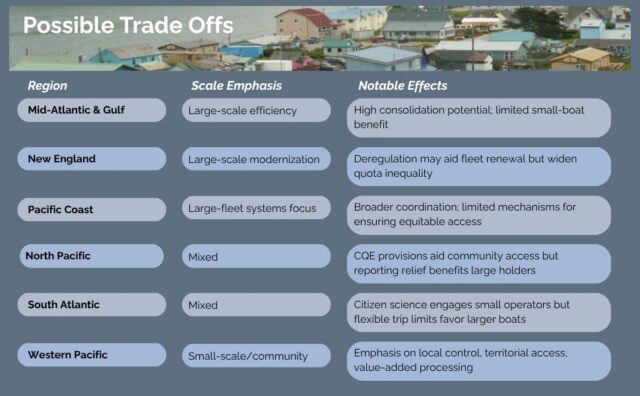
These risk points underscore the need for NOAA to pair any deregulation or modernization effort with explicit safeguards — such as small-entity impact analyses, ownership-cap tracking, and public reporting of quota concentration.
The councils’ letters collectively remind us that “competitiveness” is not a neutral concept. For capital-intensive fleets, it often means speed and scale. In fisheries central to local economies, it means resilience and fairness. In places that have both, it means careful safeguards and the ability to implement them.
If NOAA uses EO 14276 to rebuild domestic seafood strength, success will depend on whether the agency can advance both — streamlining where appropriate, but investing in small-boat access, data integrity, and ecosystem stewardship where needed most.
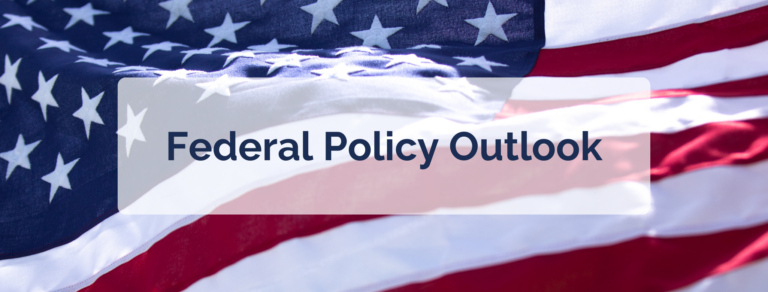
Have you heard? The government is shut down and while the Senate continues to vote on the funding measure they have been unable to get to 60 votes to fund/reopen the federal government. Some are saying they expect the shutdown to last through the end of the year but anyone’s guess is as good as ours.
Even with the government shutdown, bills that affect federal fisheries are being introduced and reviewed. We have been tracking a few of them and want to keep the on your radar:
- House introduction of the MARA Act – This bipartisan bill is companion legislation to the Senate MARA act that Ocean Strategies highlighted in our most recent special report.
- Senate committee extends Young Fishermen’s Development Act – Senate Commerce, Science and Transportation committee voted to extend this legislation providing $2 million every year for 5 years to support the next generation of commercial fishermen.
- NOAA Administrator Dr. Jacobs was confirmed by the Senate on October 7th and has officially started in the role.
Other Federal Policy
The Senate continues to conduct committee hearings, marking up and voting on legislation while the full Senate is conducting business that they can complete without the House of Representatives (who remain out of session). This includes confirmations as well as continuing to review budget proposals that would end the government shutdown.
Also notable, fisheries management and seafood inspections will continue during the government shutdown but stock assessments and other critical programs are being impacted. At the Department of Commerce (where NOAA is housed), 20% of employees (approximately 8300) remain working of the 42000 that typically staff the agency.
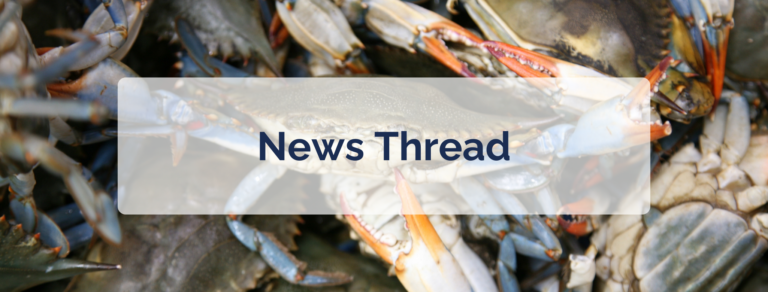
Worth Repeating
🌊 We applaud last week’s news that the Senate Commerce Committee advanced the Young Fishermen’s Development Act (YFDA) for a second 5-year period. National Fishermen surmised in a recent article, “By advancing this legislation, Congress is recommitting to America’s fishing industry, supporting workforce development, and promoting the safety, prosperity, and ingenuity of our nation’s early-career commercial fishermen,”. A great start to addressing an era-defining issue, what else will our Congresspeople come up with to find solutions to the “graying of the fleet”?
🌊 In a project funded through California Jobs First, the working waterfront community of Noyo Harbor is acquiring a new icehouse that will directly benefit its local fishing industry which generates an income of about $11.5 million annually.
🌊 NOAA Fisheries will allow commercial fishermen operating in the South Atlantic Ocean and the Gulf of America to continue fishing on expired permits amid the shutdown. The change applies only to vessel and dealer permits in the Gulf of America, South Atlantic, and those fishing highly migratory species. It doesn’t apply to commercial fishers seeking new permits or permit transfers.
Three Op-Eds of Note
🌊 Opinion: Clean water starts on land; Press Herald, Portland, Maine; August 2025.
🌊 Op-ed: From docks to dinner plates, Sea Grant delivers real value for working waterfronts; Seafood Source; September 2025.
🌊 Opinion: Let’s have an honest conversation about salmon farming in Alaska; Anchorage Daily News, Anchorage, Alaska; September, 2025
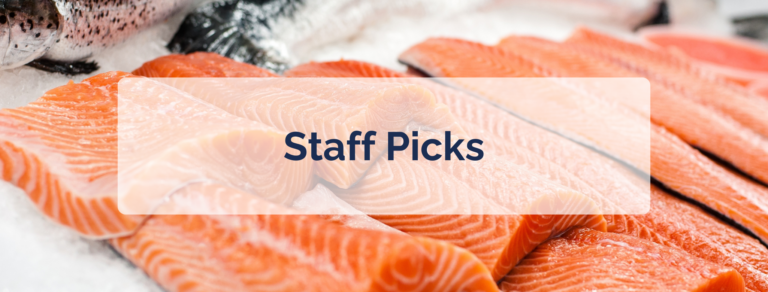
What We’re Taking In
Looking Forward to Reading
Children and adults alike will surely enjoy Tom Crestodina’s highly anticipated treasure Working Boats: Safety, Salvage & Rescue expected early 2026. Crestodina is an Alaska fisherman who began making cutaway drawings in 2011 and whose earlier tome Working Boats: A look Inside 10 Amazing Watercraft delighted fishing families around the world.
Andrew Zimmern (food equity and climate activist, Emmy and four-time James Beard award winner) and Barton Seaver (an Ocean Strategies friend and expert on seafood cookery and sustainability) published a cookbook—released this week! In connection with Fed by Blue’s James Beard Award- and Emmy-nominated PBS docuseries Hope in the Water this is touted as “a sustainable seafood bible, including a guide to environmentally friendly practices for buying and cooking food from oceans, lakes, and rivers, with over 145 recipes”. (Psst we’re also quite thrilled to report that Hope in the Water has been renewed for a second season, premiering on PBS in Spring 2026.)
Listening
UNH School of Marine Science & Ocean Engineering’s podcast Get Aquacultured! dropped a fascinating episode on October 8th, “Minorities in Aquaculture,” where they interview Ocean Strategies friend and colleague Imani Black, founder of Minorities in Aquaculture. “Discover the untold stories of Black watermen in the Chesapeake Bay and gain actionable insights on creating a more equitable and diverse seafood industry.”
Cooking
Did you know that October is both National Seafood Month AND National Pescatarian Month? One OS Team Member had crab cakes this last week while another enjoyed shrimp and grits. Thanks to the Fish Forward Substack for Octob’er’s mid month drop and a Seafood Bisque recipe that stole our hearts. Dungeness crab anyone?
Events
- November 9-11 – Local Catch Seafood Summit, Gulf Shores, Alabama

- November 19 – Mug Up with Ocean Strategies & Friends, Seattle, Washington (see visual to right)
- November 20-22 – Pacific Marine Expo, Seattle, Washington
- December 4-8 – Washington Fishermen’s Convention, Westport, Washington
- January 20-22 – Alaska Young Fishermen’s Summit, Juneau, Alaska
Here is a list of links to our most recent policy reports. You are always able to find them on our Ocean Pulse Blog. If you’d like to receive them directly, just sign up here.
